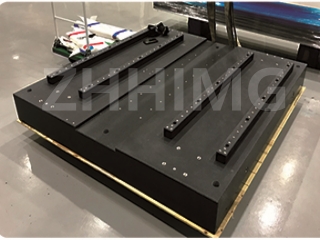Granite has been a commonly used material in the semiconductor industry for its excellent mechanical properties, thermal stability, and low coefficient of thermal expansion. However, with the ever-increasing demand for higher precision and productivity, alternative materials have emerged as viable options for the fabrication of semiconductor equipment components. In this article, we will explore some of the alternative materials for granite parts in semiconductor equipment and compare their advantages and disadvantages.
Alternative Materials for Granite Parts
1. Glass-ceramic materials
Glass-ceramic materials, such as Zerodur and Cervit, have gained widespread use in the semiconductor industry due to their low thermal expansion coefficient, which is close to that of silicon. Consequently, these materials can provide better thermal stability and enhanced precision in the semiconductor fabrication process. Zerodur, in particular, has a high degree of homogeneity and stability, making it suitable for the manufacturing of lithography equipment.
Advantages:
- Low coefficient of thermal expansion
- High precision and stability
- Suitable for high-temperature applications
Disadvantages:
- Higher cost compared to granite
- Relatively brittle, may pose challenges in machining and handling
2. Ceramics
Ceramic materials, such as aluminum oxide (Al2O3), silicon carbide (SiC), and silicon nitride (Si3N4), have excellent mechanical properties, high-temperature resistance, and low thermal expansion coefficient. These properties make ceramics ideal for semiconductor equipment parts that require high thermal stability and precision, such as wafer stages and chucks.
Advantages:
- High thermal stability and strength
- Low thermal expansion coefficient
- High wear resistance and chemical inertness
Disadvantages:
- Can be brittle and prone to cracking, especially during machining and handling
- Machining and polishing of ceramics can be challenging and time-consuming
3. Metals
Metal-based materials, such as stainless steel and titanium, have been used for some semiconductor equipment parts due to their excellent machinability and high strength. They are commonly used in applications where high thermal stability is not required, such as chamber parts, couplings, and feedthroughs.
Advantages:
- Good machinability and weldability
- High strength and ductility
- Low cost compared to some of the alternative materials
Disadvantages:
- High thermal expansion coefficient
- Not suitable for high-temperature applications due to thermal expansion issues
- Susceptible to corrosion and contamination
Conclusion:
In summary, while granite has been a popular choice for semiconductor equipment parts, alternative materials have emerged, each with unique advantages and disadvantages. Glass-ceramic materials are highly precise and stable but can be brittle. Ceramics are strong and have excellent thermal stability but can also be brittle, making them more challenging to manufacture. Metals are inexpensive, machinable, and ductile, but they have a higher coefficient of thermal expansion and are susceptible to corrosion and contamination. When selecting materials for semiconductor equipment, it is crucial to consider the specific requirements of the application and select materials that balance cost, performance, and reliability.
Post time: Mar-19-2024

